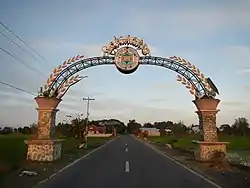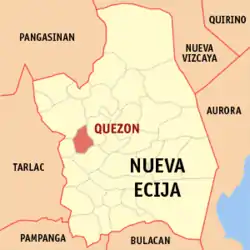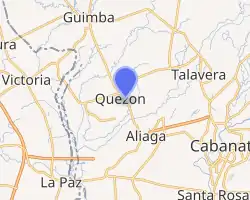Quezon, Nueva Ecija
Quezon, officially the Municipality of Quezon (Pangasinan: Baley na Quezon; Ilocano: Ili ti Quezon; Tagalog: Bayan ng Quezon; Spanish: Municipalidad de Quezon), is a 4th class municipality in the province of Nueva Ecija, Philippines that was named from the 2'nd president of the Philippines, Manuel L. Quezon. According to the 2015 census, it has a population of 40,592 people. [3]
Quezon | |
|---|---|
| Municipality of Quezon | |
 Welcome Arch | |
 Seal | |
 Map of Nueva Ecija with Quezon highlighted | |
OpenStreetMap 
| |
.svg.png.webp) Quezon Location within the Philippines | |
| Coordinates: 15°33′N 120°49′E | |
| Country | |
| Region | Central Luzon (Region III) |
| Province | Nueva Ecija |
| District | 1st District |
| Named for | Manuel L. Quezon |
| Barangays | 16 (see Barangays) |
| Government | |
| • Type | Sangguniang Bayan |
| • Mayor | Mariano Cristino N. Joson |
| • Vice Mayor | Mariano Noriel M. Joson |
| • Representative | Estrellita B. Suansing |
| • Electorate | 21,406 voters (2019) |
| Area | |
| • Total | 68.53 km2 (26.46 sq mi) |
| Elevation | 28 m (92 ft) |
| Population | |
| • Total | 40,592 |
| • Density | 590/km2 (1,500/sq mi) |
| • Households | 9,443 |
| Economy | |
| • Income class | 4th municipal income class |
| • Poverty incidence | 17.96% (2015)[4] |
| • Revenue | ₱74,179,497.74 (2016) |
| Time zone | UTC+8 (PST) |
| ZIP code | 3113 |
| PSGC | |
| IDD : area code | +63 (0)44 |
| Climate type | tropical monsoon climate |
| Native languages | Ilocano Tagalog |
Barangays
Quezon is politically subdivided into 16 barangays.
- Bertese
- Doña Lucia
- Dulong Bayan
- Ilog Baliwag
- Barangay I (Poblacion)
- Barangay II (Poblacion)
- Pulong Bahay
- San Alejandro
- San Andres I
- San Andres II
- San Manuel
- Santa Clara
- Santa Rita
- Santo Cristo
- Santo Tomas Feria
- San Miguel
Climate
| Climate data for Quezon, Nueva Ecija | |||||||||||||
|---|---|---|---|---|---|---|---|---|---|---|---|---|---|
| Month | Jan | Feb | Mar | Apr | May | Jun | Jul | Aug | Sep | Oct | Nov | Dec | Year |
| Average high °C (°F) | 28 (82) |
29 (84) |
30 (86) |
32 (90) |
31 (88) |
30 (86) |
29 (84) |
28 (82) |
28 (82) |
28 (82) |
29 (84) |
28 (82) |
29 (84) |
| Average low °C (°F) | 18 (64) |
18 (64) |
19 (66) |
20 (68) |
22 (72) |
22 (72) |
22 (72) |
22 (72) |
22 (72) |
22 (72) |
20 (68) |
18 (64) |
20 (69) |
| Average precipitation mm (inches) | 4 (0.2) |
6 (0.2) |
7 (0.3) |
12 (0.5) |
61 (2.4) |
89 (3.5) |
96 (3.8) |
99 (3.9) |
81 (3.2) |
88 (3.5) |
37 (1.5) |
13 (0.5) |
593 (23.5) |
| Average rainy days | 2.5 | 3.0 | 4.1 | 6.3 | 15.8 | 19.4 | 22.5 | 21.6 | 20.1 | 17.5 | 9.6 | 4.0 | 146.4 |
| Source: Meteoblue [5] | |||||||||||||
Demographics
| Year | Pop. | ±% p.a. |
|---|---|---|
| 1918 | 6,314 | — |
| 1939 | 8,780 | +1.58% |
| 1948 | 9,452 | +0.82% |
| 1960 | 10,953 | +1.24% |
| 1970 | 15,842 | +3.75% |
| 1975 | 17,178 | +1.64% |
| 1980 | 20,846 | +3.95% |
| 1990 | 25,574 | +2.07% |
| 1995 | 29,172 | +2.50% |
| 2000 | 31,720 | +1.81% |
| 2007 | 33,988 | +0.96% |
| 2010 | 36,660 | +2.79% |
| 2015 | 40,592 | +1.96% |
| Source: Philippine Statistics Authority [3] [6] [7][8] | ||
References
- Municipality of Quezon | (DILG)
- "Province: Nueva Ecija". PSGC Interactive. Quezon City, Philippines: Philippine Statistics Authority. Retrieved 12 November 2016.
- Census of Population (2015). "Region III (Central Luzon)". Total Population by Province, City, Municipality and Barangay. PSA. Retrieved 20 June 2016.
- "PSA releases the 2015 Municipal and City Level Poverty Estimates". Quezon City, Philippines. Retrieved 1 January 2020.
- "Quezon: Average Temperatures and Rainfall". Meteoblue. Retrieved 4 May 2020.
- Census of Population and Housing (2010). "Region III (Central Luzon)". Total Population by Province, City, Municipality and Barangay. NSO. Retrieved 29 June 2016.
- Censuses of Population (1903–2007). "Region III (Central Luzon)". Table 1. Population Enumerated in Various Censuses by Province/Highly Urbanized City: 1903 to 2007. NSO.
- "Province of Nueva Ecija". Municipality Population Data. Local Water Utilities Administration Research Division. Retrieved 17 December 2016.
External links
| Wikimedia Commons has media related to Quezon, Nueva Ecija. |
- Quezon Profile at PhilAtlas.com
- Philippine Standard Geographic Code
- Philippine Census Information
- Local Governance Performance Management System
This article is issued from Wikipedia. The text is licensed under Creative Commons - Attribution - Sharealike. Additional terms may apply for the media files.